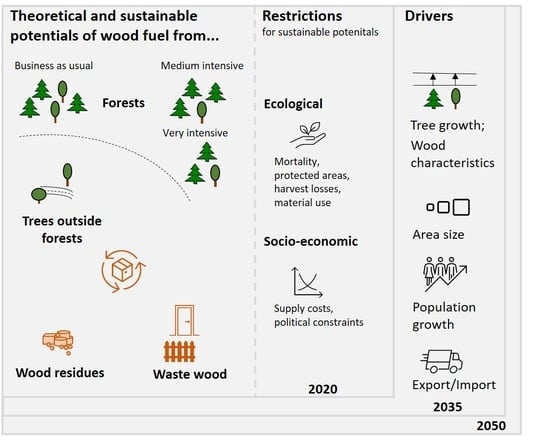Current (2020) and Long-Term (2035 and 2050) Sustainable Potentials of Wood Fuel in Switzerland
Abstract
1. Introduction
- (i)
- What sustainable potential of woody biomass feedstocks can be used for wood fuel today (2020) in the long term (2035; 2050), and what is the impact on the key drivers to predict future amount of wood fuel?
- (ii)
- What are realistic ranges of wood fuel predictions under different (a) forest management strategies, (b) ecological restrictions (e.g., protected areas, harvest losses), (c) wood markets (material use, recycling/upcycling) and (d) costs?
- (iii)
- What are the consequences of additional wood fuel use (e.g., effects of different costs)?
2. Materials and Methods
2.1. Derivation of Wood Fuel Potentials
- (i)
- Theoretical and sustainable wood fuel potentials. Biophysical constraints and forest management strategies largely regulate the increment and possible stock reductions in forests and other landscapes, resulting in the theoretical potentials (TPs), and thereby determine the upper limit of annual wood fuel use. By subtracting relevant ecological and socio-economic restrictions, the amounts of biomass available for wood fuel are reduced, resulting in the sustainable potentials (SPs). SP provides a more realistic estimation of the amount of wood fuel produced annually and is the consequence of balancing societies’ multifunctional forestry mandates [20,23,44]. However, some restrictions have only indirect effects on wood residues and waste wood as they occur after timber harvesting (dashed line in Figure 1). For both TPs and SPs, the specific assumptions made for each woody biomass type are described in the respective sections. In the case of wood fuel derived from forests, we additionally determined the ecologically sustainable potential (ESP), which provides the upper limit if significantly lower costs, higher prices and consequently larger revenues are expected and mainly ecological constraints dominate (cf. Figure 2).
- (ii)
- Forest management strategies. Three forest management strategies were simulated by using MASSIMO [45], a management scenario simulation model to project growth, harvests and carbon dynamics of Swiss forests. It is based on empirical models that have been fitted with data from the Swiss NFI [46], and it includes HeProMo [47,48], a model that can estimate potential timber harvesting productivities and costs. Thus, it was possible to estimate the harvesting cost for each NFI plot based on the amount of harvested timber, harvesting methods and transport distance to the nearest forest road. It was initialized on 5086 NFI sample plots with productive forests, based on NFI2 (1983–1985) and NFI3 (2004–2006) surveys. As MASSIMO includes random components, we replicated the simulations 20 times. The version applied (NFI2/NFI3) does not take into account climate change but includes random components for storm damage, harvesting and single tree mortality [45], thereby taking into account climate-induced extreme events that can cause major damage and further impact the wood-processing industries and trades [49]. The following forest management strategies were calculated:
- Business as usual, representing a continuous growing stock increase (CSI). It reflects the current harvesting and management practices in Switzerland and therefore can be seen as a reference scenario. It leads to increasing growing stocks in all Swiss regions except for the Swiss Plateau.
- Medium-intensity management, representing a moderate stock reduction (MSR). It targets growing stocks of 300–310 m3/ha until 2046 and is intended to accelerate growth by reducing the stock of the forests.
- High-intensity management, representing a large stock reduction (LSR). It accounts for a high demand for wood fuel from forests until 2046, leading to more frequent thinning and 40% shorter rotations, with target growing stocks of 250 m3/ha and a range of 200–300 m3/ha.
- (iii)
- Level of wood fuel consumption. Three scenarios of wood fuel use were applied to estimate realistic ranges of TPs and SPs. They were calculated for all analyzed types of biomass and covered the minimum, maximum and expected levels of wood fuel consumption. The largest deductions due to the restrictions (i) result in the minimum, the smallest in the maximum and the deductions of average restrictions in the expected potentials. Thereby, the approach accounts for uncertainties and diverse viewpoints regarding the potentials use (cf. Figure 2).
- (iv)
- Timber market situations. Two timber market situations were considered, wood energy oriented (EO+) and less wood energy oriented (EO−). They differ in the sorting of the assortments and include the differentiation between wood for energy and for material uses (Supplementary Information S1, Table S5). The market situation EO+ represents a more energy-intensive use directly after harvesting. In contrast, EO− represents a more cascade-oriented market, where a greater share of wood is directed towards a preliminary material use and is available for energy as wood residues or waste wood at the end of the life cycle. Both EO− and EO+ were defined in coordination with the Swiss forestry and timber industry associations [50].
- (v)
- Key drivers. The consideration of biomass-specific key drivers serves to project the wood fuel potentials of all analyzed woody biomass types by using them as development indicators of TP. We subtracted the relevant biomass-specific restrictions from future TPs to determine SPs. Detailed information on the biomass-specific drivers is given in the corresponding Section 2.2.1, Section 2.2.2, Section 2.2.3 and Section 2.2.4. In some cases, information on the possible development of the present SPs was also available and was applied directly.
2.2. Assessment of Woody Biomass Types
- (i)
- Wood fuel from forests, which is extracted from forests and used directly for energy purposes.
- (ii)
- Wood fuel from trees outside forests, which is from trees and shrubs cut and pruned on landscapes or settlement areas outside forests.
- (iii)
- Wood fuel from wood residues, which includes slabs, cuttings, sawdust and wood shavings that arise in the wood product manufacturing and processing industries [52]. These residues are mainly a by-product of saw-, planing- and gluing mills, carpentries and joineries within the woodworking industry. The potentials depend on (i) the amount of wood harvested in forests, and (ii) its assortments, which has the advantage of framing the potentials in relation to their original source.
- (iv)
- Wood fuel from waste wood, which is defined as waste (after the material use of a wooden product) [53] and includes packaging made of wood, waste wood from building sites, demolitions, renovations and conversions, and shredded wood, including sieve overflow.
2.2.1. Wood Fuel from Forests
2.2.2. Wood Fuel from Trees Outside Forests
2.2.3. Wood Fuel from Wood Residues
2.2.4. Wood Fuel from Waste Wood
2.2.5. Calculation of Energy Contents
3. Results
3.1. Wood Fuel from Forests
3.1.1. Theoretical Potential
3.1.2. Sustainable Potential
3.2. Wood Fuel from Trees Outside Forests
3.2.1. Theoretical Potential
3.2.2. Sustainable Potential
3.3. Wood Fuel from Wood Residues
3.3.1. Theoretical Potential
3.3.2. Sustainable Potential
3.4. Wood Fuel from Waste Wood
3.4.1. Theoretical Potential
3.4.2. Sustainable Potential
3.5. All Woody Biomass Types
4. Discussion
4.1. Context of Wood Fuel Potentials
4.2. Alternative Forest Wood Management Strategies
4.3. Level of Wood Fuel Consumption
4.4. Other Key Drivers and Critical Remarks
5. Conclusions
Supplementary Materials
Author Contributions
Funding
Acknowledgments
Conflicts of Interest
References
- George, G.; Schillebeeckx, S.J.D.; Liak, T.L. The Management of Natural Resources: An Overview and Research Agenda. Acad. Manag. J. 2015, 58, 1595–1613. [Google Scholar]
- Kirchner, A.; Bredow, F.; Grebel, T.; Hofer, P.; Kemmler, A.; Ley, A.; Piégsa, A.; Schütz, N.; Strassburg SStruwe, J. Die Energieperspektiven für die Schweiz bis 2050, Energienachfrage und Elektrizitätsangebot in der Schweiz 2000–2050; Prognos AG: Basel, Switzerland, 2012; p. 842. [Google Scholar]
- Long, H.; Li, X.; Wang, H.; Jia, J. Biomass resources and their bioenergy potential estimation: A review. Renew. Sustain. Energy Rev. 2013, 26, 344–352. [Google Scholar]
- Li, Y.; Rezgui, Y.; Zhu, H. District heating and cooling optimization and enhancement—Towards integration of renewables, storage and smart grid. Renew. Sustain. Energy Rev. 2017, 72, 281–294. [Google Scholar]
- Lauri, P.; Havlík, P.; Kindermann, G.; Forsell, N.; Böttcher, H.; Obersteiner, M. Woody biomass energy potential in 2050. Energy Policy 2013, 66, 19–31. [Google Scholar]
- Reid, W.V.; Ali, M.K.; Field, C.B. The future of bioenergy. Glob. Chang. Biol. 2020, 26, 274–286. [Google Scholar]
- European Academies Science Advisory Council. Multi-Functionality and Sustainability in the European Union’s Forests; German National Academy of Sciences: Halle, Germany, 2017; p. 51. [Google Scholar]
- Sigsgaard, T.; Forsberg, B.; Annesi-Maesano, I.; Blomberg, A.; Bølling, A.; Boman, C.; Bønløkke, J.; Brauer, M.; Bruce, N.; Héroux, M.-E.; et al. Health impacts of anthropogenic biomass burning in the developed world. Eur. Respir. J. 2015, 46, 1577–1588. [Google Scholar]
- Barreiro, S.; Schelhaas, M.-J.; Kändler, G.; Antón-Fernández, C.; Colin, A.; Bontemps, J.-D.; Alberdi, I.; Condés, S.; Dumitru, M.; Ferezliev, A.; et al. Overview of methods and tools for evaluating future woody biomass availability in European countries. Ann. For. Sci. 2016, 73, 823–837. [Google Scholar]
- Schuldt, B.; Buras, A.; Arend, M.; Vitasse, Y.; Beierkuhnlein, C.; Damm, A.; Gharun, M.; Grams, T.E.; Hauck, M.; Hajek, P.; et al. A first assessment of the impact of the extreme 2018 summer drought on Central European forests. Basic Appl. Ecol. 2020, 45, 86–103. [Google Scholar]
- Bowditch, E.; Santopuoli, G.; Binder, F.; Del Río, M.; La Porta, N.; Kluvankova, T.; Lesinski, J.; Motta, R.; Pach, M.; Panzacchi, P.; et al. What is Climate-Smart Forestry? A definition from a multinational collaborative process focused on mountain regions of Europe. Ecosyst. Serv. 2020, 43, 101113. [Google Scholar]
- Schweier, J.; Magagnotti, N.; Labelle, E.R.; Athanassiadis, D. Sustainability Impact Assessment of Forest Operations: A Review. Curr. For. Rep. 2019, 5, 101–113. [Google Scholar]
- Federal Office for the Environment (FOEN); Swiss Federal Office of Energy (SFOE); State Secretariat for Economic Affairs (SECO). (Eds.) Ressourcenpolitik Holz. Strategie, Ziele und Aktionsplan Holz; Federal Office of the Environment (FOEN)/Federal Office of Energy (SFOE)/State Secretariat for Economic Affairs (SECO): Bern, Switzerland, 2018; p. 62. [Google Scholar]
- Federal Office for the Environment (FOEN); Swiss Federal Office of Energy (SFOE); State Secretariat for Economic Affairs (SECO). (Eds.) Ressourcenpolitik Holz. Strategie, Ziele und Aktionsplan Holz; Federal Office of the Environment (FOEN)/Federal Office of Energy (SFOE)/State Secretariat for Economic Affairs (SECO): Bern, Switzerland, 2014; p. 36. [Google Scholar]
- Mehr, J.; Vadenbo, C.; Steubing, B.; Hellweg, S. Environmentally optimal wood use in Switzerland—Investigating the relevance of material cascades. Resour. Conserv. Recycl. 2018, 131, 181–191. [Google Scholar]
- Farrell, E.P.; Führer, E.; Ryan, D.; Andersson, F.; Hüttl, R.; Piussi, P. European forest ecosystems: Building the future on the legacy of the past. For. Ecol. Manag. 2000, 132, 5–20. [Google Scholar]
- Brändli, U.B.; Abegg, M.; Allgaier, L. (Red.), Swiss National Forest Inventory, Results of the Fourth Survey 2009–2017; Swiss Federal Institute for Forest, Snow and Landscape Research WSL: Birmensdorf, Switzerland; Federal Office of the Environment (FOEN): Bern, Switzerland, 2020; p. 341. [Google Scholar]
- Schulze, E.-D.; Sierra, C.A.; Egenolf, V.; Woerdehoff, R.; Irslinger, R.; Baldamus, C.; Stupak, I.; Spellmann, H. The climate change mitigation effect of bioenergy from sustainably managed forests in Central Europe. GCB Bioenergy 2020, 12, 186–197. [Google Scholar]
- Zhang, F.; Johnson, D.M.; Wang, J.; Liu, S.; Zhang, S. Measuring the Regional Availability of Forest Biomass for Biofuels and the Potential of GHG Reduction. Energies 2018, 11, 198. [Google Scholar]
- Thees, O.; Erni, M.; Lemm, R.; Stadelmann, G.; Zenner, E.K. Future potentials of sustainable wood fuel from forests in Switzerland. Biomass Bioenergy 2020, 141, 105647. [Google Scholar]
- Wörsdörfer, M. The Future of Petrochemicals, Director of Sustainability, Technology and Outlooks; Brussels-EU Refining Forum: Brussels, Belgium, 2018. [Google Scholar]
- Hu, H.; Wu, M. Heavy oil-derived carbon for energy storage applications. J. Mater. Chem. A 2020, 8, 7066–7082. [Google Scholar]
- Searle, S.; Malins, C. A reassessment of global bioenergy potential in 2050. GCB Bioenergy 2015, 7, 328–336. [Google Scholar]
- Bončina, A.; Simončič, T.; Rosset, C. Assessment of the concept of forest functions in Central European forestry. Environ. Sci. Policy 2019, 99, 123–135. [Google Scholar]
- Trutnevyte, E.; Guivarch, C.; Lempert, R.; Strachan, N. Reinvigorating the scenario technique to expand uncertainty consideration. Clim. Chang. 2016, 135, 373–379. [Google Scholar]
- Hepperle, F. Prognosemodell zur Abschätzung des Regionalen Waldenergieholzpotenzials auf der Grundlage Forstlicher Inventur- und Planungsdaten unter Berücksichtigung Ökologischer, Technischer und Wirtschaftlicher Nutzungseinschränkungen; Fakultät für Forst und Umweltwissenschaften der Albert-Ludwigs-Universität Freiburg im Breisgau: Freiburg im Breisgau, 2010; p. 165. [Google Scholar]
- Baier, U.; Baum, S. Biogene Güterflüsse der Schweiz 2006, Massen- und Energieflüsse; Bundesamt für Umwelt (BAFU): Bern, Switzerland, 2006; p. 114. [Google Scholar]
- Balat, M. Use of biomass sources for energy in Turkey and a view to biomass potential. Biomass Bioenergy 2005, 29, 32–41. [Google Scholar]
- Steubing, B.; Zah, R.; Waeger, P.; Ludwig, C. Bioenergy in Switzerland: Assessing the domestic sustainable biomass potential. Renew. Sustain. Energy Rev. 2010, 14, 2256–2265. [Google Scholar]
- Burg, V.; Bowman, G.; Erni, M.; Lemm, R.; Thees, O. Analyzing the potential of domestic biomass resources for the energy transition in Switzerland. Biomass Bioenergy 2018, 111, 60–69. [Google Scholar]
- Thrän, D.; Seidenberger, T.; Zeddies, J.; Offermann, R. Global biomass potentials—Resources, drivers and scenario results. Energy Sustain. Dev. 2010, 14, 200–205. [Google Scholar]
- Verkerk, P.J.; Fitzgerald, J.B.; Datta, P.; Dees, M.; Hengeveld, G.M.; Lindner, M.; Zudin, S. Spatial distribution of the potential forest biomass availability in Europe. For. Ecosyst. 2019, 6, 1–11. [Google Scholar]
- Vavrova, K.; Knapek, J.; Weger, J. Short-term Boosting of Biomass Energy Sources—Determination of Biomass Potential for Prevention of Regional Crisis Situations. Renew. Sustain. Energy Rev. 2017, 67, 426–436. [Google Scholar]
- Gustavsson, L.; Sathre, R. Variability in energy and carbon dioxide balances of wood and concrete building materials. Build. Environ. 2006, 41, 940–951. [Google Scholar]
- Hagemann, N.; Gawel, E.; Purkus, A.; Pannicke, N.; Hauck, J. Possible Futures towards a Wood-Based Bioeconomy: A Scenario Analysis for Germany. Sustainability 2016, 8, 98. [Google Scholar]
- Vadenbo, C.; Tonini, D.; Burg, V.; Astrup, T.F.; Thees, O.; Hellweg, S. Environmental optimization of biomass use for energy under alternative future energy scenarios for Switzerland. Biomass Bioenergy 2018, 119, 462–472. [Google Scholar]
- Heräjärvi, H.; Kunttu, J.; Hurmekoski, E.; Hujala, T. Outlook for modified wood use and regulations in circular economy. Holzforschung 2019, 2019, 10. [Google Scholar]
- Aylott, M.J.; Casella, E.; Tubby, I.; Street, N.R.; Smith, P.; Taylor, G. Yield and spatial supply of bioenergy poplar and willow short-rotation coppice in the UK. New Phytol. 2008, 178, 358–370. [Google Scholar]
- Burg, V.; Bowman, G.; Hellweg, S.; Thees, O. Long-Term Wet Bioenergy Resources in Switzerland: Drivers and Projections until 2050. Energies 2019, 12, 3585. [Google Scholar]
- Werner, C.; Haas, E.; Grote, R.; Gauder, M.; Graeff-Hönninger, S.; Claupein, W.; Butterbach-Bahl, K.; Grote, R. Biomass production potential fromPopulusshort rotation systems in Romania. GCB Bioenergy 2012, 4, 642–653. [Google Scholar]
- Aust, C.; Schweier, J.; Brodbeck, F.; Sauter, U.H.; Becker, G.; Schnitzler, J.-P. Land availability and potential biomass production with poplar and willow short rotation coppices in Germany. GCB Bioenergy 2014, 6, 521–533. [Google Scholar]
- Van Meerbeek, K.; Muys, B.; Hermy, M. Lignocellulosic biomass for bioenergy beyond intensive cropland and forests. Renew. Sustain. Energy Rev. 2019, 102, 139–149. [Google Scholar]
- Brosowski, A.; Thrän, D.; Mantau, U.; Mahrod, B.; Erdmann, G.; Adlera, P.; Stinner, W.; Reinholde, G.; Heringe, T.; Blankec, C. A Review of Biomass Potential and Current Utilisation—Status quo for 93 Biogenic Wastes and Residues in Germany. Biomass Bioenergy 2016, 95, 257–272. [Google Scholar]
- Mantau, U.; Saal, U.; Prins, K.; Streierer, F.; Lindner, M.; Verkerk, H.; Eggers, J.; Leek, N.; Oldenburger, J. EUwood—Real Potential for Changes in Growth and Use of EU Forests 2010, Final Report; EFI: Hamburg, Germany, 2010; p. 160. [Google Scholar]
- Stadelmann, G.; Temperli, C.; Rohner, B.; Didion, M.; Herold, A.; Rösler, E.; Thürig, E. Presenting MASSIMO: A Management Scenario Simulation Model to Project Growth, Harvests and Carbon Dynamics of Swiss Forests. Forests 2019, 10, 94. [Google Scholar]
- Brändli, U.-B. (Ed.) Ergebnisse der Dritten Erhebung 2004–2006; Schweizerisches Landesforstinventar; Eidg. Forschungsanstalt für Wald, WSL: Birmensdorf, Switzerland; Bundesamt für Umwelt (BAFU): Bern, Switzerland, 2010; p. 316. [Google Scholar]
- Frutig, F.; Thees, O.; Lemm, R.; Kostadinov, F. Holzernteproduktivitätsmodelle HeProMo-Konzeption, Realisierung, Nutzung und Weiterentwicklung, Grundlagen, Methoden und Instrumente; Eidg. Forschungsanstalt WSL: Birmensdorf, Switzerland, 2009; pp. 441–466. [Google Scholar]
- Holm, S.; Frutig, F.; Lemm, R.; Thees, O.; Schweier, J. HeProMo: A Decision Support Tool to Estimate Wood Harvesting Productivities. PLoS ONE 2020. Submitted. [Google Scholar]
- Federal Office for the Environment (FOEN). Faktenblatt zur Strategie des Bundesrates «Anpassung an den Klimawandel in der Schweiz»; Anpassung an den Klimawandel; Sektor Waldwirtschaft: Bern, Switzerland, 2013. [Google Scholar]
- Thees, O.; Kaufmann, E.; Lemm, R.; Bürgi, A. Energieholzpotenziale im Schweizer Wald. Schweiz. Z. Forstwes. 2013, 164, 351–364. [Google Scholar]
- Thees, O.; Burg, V.; Erni, M.; Bowman, G.; Lemm, R. Biomassenpotenziale der Schweiz für die Energetische Nutzung, Ergebnisse des Schweizerischen Energiekompetenzzentrums SCCER BIOSWEET; Eidg. Forschungsanstalt für Wald Schnee und Landschaft (WSL): Birmensdorf, Switzerland, 2017; p. 299. [Google Scholar]
- Federal Statistical Office (FSO). Entwicklung des Rundhzolzeinschittes in den Sägereien Nach Kantonen; FSO: Neuchâtel, Switzerland, 2018. [Google Scholar]
- Der Schweizerische Bundesrat, Verordnung über den Verkehr mit Abfällen (VeVA). 2005. (Fassung Juli 2016). Available online: https://docplayer.org/21490070-Verordnung-ueber-den-verkehr-mit-abfaellen.html (accessed on 18 November 2020).
- Stadelmann, G.; Herold, A.; Didion, M.; Vidondo, B.; Gomez, A.; Thürig, E. Holzerntepotenzial im Schweizer Wald: Simulation von Bewirtschaftungsszenarien. Schweiz. Z. Forstwes. 2016, 167, 152–161. [Google Scholar]
- Temperli, C.; Stadelmann, G.; Thürig, E.; Brang, P. Timber Mobilisation and Habitat Tree Retention in Low-Elevation mixed Forests in Switzerland: An Inventory-based Scenario Analysis of Opportunities and Constraints. Eur. J. For. Res. 2017, 136, 711–725. [Google Scholar]
- Ginzler, C.; Brändli, U.-B.; Hägeli, M. Waldflächenentwicklung der letzten 120 Jahre in der Schweiz. Schweiz. Z. Forstwes. 2011, 162, 337–343. [Google Scholar]
- Bircher, N.; Cailleret, M.; Huber, M.; Bugmann, H. Empfindlichkeit typischer Schweizer Waldbestände auf den Klimawandel. Schweiz. Z. Forstwes. 2015, 166, 408–419. [Google Scholar]
- Mina, M.; Bugmann, H.; Cordonnier, T.; Irauschek, F.; Klopčič, M.; Pardos, M.; Cailleret, M. Future ecosystem services from European mountain forests under climate change. J. Appl. Ecol. 2017, 54, 389–401. [Google Scholar]
- Rohner, B.; Kumar, S.; Liechti, K.; Gessler, A.; Ferretti, M. Tree Vitality Indicators Revealded a Reapid Response of Beech Forests to the 2018 Drought. Ecol. Indic. 2021, 120, 106903. [Google Scholar]
- Rohner, B.; Waldner, P.; Lischke, H.; Ferretti, M.; Thürig, E. Predicting individual-tree growth of central European tree species as a function of site, stand, management, nutrient, and climate effects. Eur. J. For. Res. 2018, 137, 29–44. [Google Scholar]
- Trotsiuk, V.; Hartig, F.; Cailleret, M.; Babst, F.; Forrester, D.I.; Baltensweiler, A.; Buchmann, N.; Bugmann, H.; Gessler, A.; Gharun, M.; et al. Assessing the response of forest productivity to climate extremes in Switzerland using model–data fusion. Glob. Chang. Biol. 2020, 26, 2463–2476. [Google Scholar]
- Nabuurs, G.-J.; Pussinen, A.; Karjalainen, T.; Erhard, M.; Kramer, K. Stemwood volume increment changes in European forests due to climate change—A simulation study with the EFISCEN model. Glob. Chang. Biol. 2002, 8, 304–316. [Google Scholar]
- Abegg, M.; Brändli, U.-B.; Cioldi, F.; Fischer, C.; Herold-Bonardi, A.; Huber, M.; Keller, M.; Meile, R.; Rösler, E.; Speich, S.; et al. Schweizerisches Landesforstinventar—Ergebnistabelle Nr. 173534: Jährlicher Nettozuwachs; Eidg. Forschungsanstalt WSL: Birmensdorf, Switzerland, 2014. [Google Scholar]
- Losey, S.; Wehrli, A. Schutzwald in der Schweiz. Vom Projekt SilvaProtect-CH zum harmonisierten Schutzwald; Bundesamt für Umwelt (BAFU): Bern, Switzerland, 2013; p. 29. [Google Scholar]
- Federal Office for the Environment (FOEN). Waldpolitik 2020, Visionen, Ziele, Massnahmen für Eine Nachhaltige Bewirtschaftung des Schweizer Waldes; FOEN: Bern, Switzerland, 2013; p. 66. [Google Scholar]
- Federal Statistical Office (FSO). Areal Statistics Switzerland, Standard Nomenclature, Data Set, Hectare Level; FSO: Neuchâtel, Switzerland, 2009. [Google Scholar]
- Federal Office for the Environment (FOEN); Swiss Federal Office of Energy (SFOE). Energieholzpotenziale Ausserhalb des Waldes; Federal Office for the Environment (FOEN)/Swiss Federal Office of Energy (SFOE): Bern, Switzerland, 2009; p. 82. [Google Scholar]
- Federal Statistical Office (FSO). Digital Elevation Model (100 m); GEOSTAT: Neuchâtel, Switzerland, 1979. [Google Scholar]
- Swisstopo Federal Office of Topography. Digital Land Model of Switzerland, Vector 25; Swisstopo Federal Office of Topography: Bern, Switzerland, 2007. [Google Scholar]
- Federal Office for the Environment (FOEN). Jahrbuch Wald und Holz; Federal Office for the Environment (FOEN): Bern, Switzerland, 2014; p. 162. [Google Scholar]
- Erni, M.; Thees, O.; Lemm, R. Altholzpotenziale der Schweiz für die Energetische Nutzung, Ergebnisse einer Vollerhebung; WSL Ber. 52; Eidg. Forschungsanstalt WSL: Birmensdorf, Switzerland, 2017; p. 68. [Google Scholar]
- Mantau, U.; Weimar, H.; Kloock, T. Standorte der Holzwirtschaft, Holzrohstoffmonitoring, Altholz im Entsorgungsmarkt, Aufkommens- und Vertriebsstruktur 2010; Universität Hamburg: Hamburg, Germany, 2012; p. 30. [Google Scholar]
- Federal Office for the Environment (FOEN). Jahrbuch Wald und Holz; Federal Office for the Environment (FOEN): Bern, Switzerland, 2018. [Google Scholar]
- Kohli, R.; Bläuer, A.; Perrenoud, S.; Babel, J. Szenarien zur Bevölkerungsentwicklung der Schweiz 2015–2045; Bundesamt für Statistik (BFS): Neuchãtel, Switzerland, 2015; p. 82. [Google Scholar]
- Taverna, R.; Meister, R.; Hächler, K. Abschätzung des Altholzaufkommens und des CO2-Effektes aus Seiner Energetischen Verwertung, Schlussbericht, Bundesamt für Umwelt (BAFU); Departement für Umwelt, Verkehr, Energie und Kommunikation (UVEK): Bern, Switzerland, 2010; p. 63. [Google Scholar]
- Lehner, L.; Kinnunen, U.; Weidner, J.; Lehner, J.; Pauli, B.; Menk, J. Branchenanalyse, Analyse und Synthese der Wertschöpfungskette (WSK) Wald und Holz in der Schweiz, Bern, Bundesamt für Umwelt (BAFU); Eidg. Departements für Umwelt, Verkehr, Energie und Kommunikation (UVEK): Bern, Switzerland, 2014; p. 345. [Google Scholar]
- Hahn, J.; Schardt, M.; Schulmeyer, F.; Mergler, F. Der Energieinhalt von Holz; Bayerische Landesanstalt für Wald und Forstwirtschaft (LWF): Freising, Germany, 2014; p. 4. [Google Scholar]
- Swiss Federal Office of Energy (SFOE). Masse, Einheiten, Zahlen: Umrechnungsfaktoren, Masseinheiten und Energieinhalte; SFOE: Bern, Switzerland, 2006; p. 1. [Google Scholar]
- Federal Statistical Office (FSO). Restholzverwertung in den Sägereien nach Kantonen 2012, Tab 7.3.5.3; FSO: Neuchâtel, Switzerland, 2013. [Google Scholar]
- Federal Office of Energy (SFOE). Überblick über den Energieverbrauch der Schweiz im Jahr 2019, Auszug aus der Schweizerischen Gesamtenergiestatistik 2019; SFOE: Bern, Switzerland, 2020; p. 9. [Google Scholar]
- MeteoSchweiz. Der Wintersturm Burglind/Eleanor in der Schweiz, Fachbericht; MeteoSchweiz: Zurich, Switzerland, 2018; p. 35. [Google Scholar]
- Marcucci, A.; Zhang, L. Growth impacts of Swiss steering-based climate policies. Swiss J. Econ. Stat. 2019, 155, 1–13. [Google Scholar]
- Yousefpour, R.; Temperli, C.; Jacobsen, J.B.; Thorsen, B.J.; Meilby, H.; Lexer, M.J.; Lindner, M.; Bugmann, H.; Borges, J.G.; Palma, J.H.; et al. A framework for modeling adaptive forest management and decision making under climate change. Ecol. Soc. 2017, 22, 40. [Google Scholar]
- Stroheker, S.; Forster, B.; Queloz, V. Zweithöchster je Registrierter Buchdruckerbefall (Ips Typographus) in der Schweiz; Waldschutz Aktuell; Eidg. Forschungsanstalt WSL: Birmensdorf, Switzerland, 2020; p. 2. [Google Scholar]
- Federal Office of the Environment (FOEN). 2018 Market Statement for Switzerland, Developments in Forest Product Markets; FOEN: Bern, Switzerland, 2018; p. 31. [Google Scholar]
- Ede, A.N.; Adebayo, S.O.; Ugwu, E.I.; Emenike, C. Life Cycle Assessment of Environmental Impacts of using Concrete or Timber to Construct a Duplex Residential Building. IOSR J. Mech. Civ. Eng. 2014, 11, 62–72. [Google Scholar]
- Abasian, F.; Rönnqvist, M.; Ouhimmou, M. Forest bioenergy network design under market uncertainty. Energy 2019, 188, 116038. [Google Scholar]
- Mair-Bauernfeind, C.; Stern, T. Cascading Utilization of Wood: A Matter of Circular Economy? Curr. For. Rep. 2017, 3, 281–295. [Google Scholar]
- Jarre, M.; Petit-Boix, A.; Priefer, C.; Meyer, R.; Leipold, S. Transforming the Bio-based Sector Towards a Circular Economy—What can we learn from Wood Cascading? For. Policy Econ. 2020, 110, 1–12. [Google Scholar]
- Shahab, R.L.; Brethauer, S.; Davey, M.P.; Smith, A.G.; Vignolini, S.; Luterbacher, J.S.; Studer, M. A heterogeneous microbial consortium producing short-chain fatty acids from lignocellulose. Science 2020, 369, 9. [Google Scholar]
- Holzindustrie Schweiz (HIS). Annual Report of the European Sawmill Industry 2018/2019, EOS ANNUAL REPORT, Brumunddal, Norway; HIS: Bern, Switzerland, 2019; p. 226. [Google Scholar]
- Suter, F.; Steubing, B.; Hellweg, S. Life Cycle Impacts and Benefits of Wood along the Value Chain: The Case of Switzerland. J. Ind. Ecol. 2016, 21, 874–886. [Google Scholar]
- Röder, M.; Thornley, P. Waste wood as bioenergy feedstock. Climate change impacts and related emission uncertainties from waste wood based energy systems in the UK. Waste Manag. 2018, 74, 241–252. [Google Scholar]
- Der Schweizerische Bundesrat. Luftreinhalte-Verordnung (LRV); Der Schweizerische Bundesrat: Bern, Switzerland, 2016; p. 98. [Google Scholar]
- Der Shweizerische Bundesrat. Verordnung über die Vermeidung und die Entsorgung von Abfällen; Der Shweizerische Bundesrat: Bern, Switzerland, 2015; p. 46. [Google Scholar]
- Suominen, T.; Kunttu, J.; Jasinevičius, G.; Tuomasjukka, D.; Lindner, M. Trade-offs in sustainability impacts of introducing cascade use of wood. Scand. J. For. Res. 2017, 32, 588–597. [Google Scholar]
- Röder, M.; Thornley, P. Bioenergy as climate change mitigation option within a 2 °C target—Uncertainties and temporal challenges of bioenergy systems. Energy Sustain. Soc. 2016, 6, 1–7. [Google Scholar]
- Husgafvel, R.; Linkosalmi, L.; Hughes, M.; Kanerva, J.; Dahl, O. Forest sector circular economy development in Finland: A regional study on sustainability driven competitive advantage and an assessment of the potential for cascading recovered solid wood. J. Clean. Prod. 2018, 181, 483–497. [Google Scholar]
- Näyhä, A. Transition in the Finnish forest-based sector: Company perspectives on the bioeconomy, circular economy and sustainability. J. Clean. Prod. 2019, 209, 1294–1306. [Google Scholar]
- Boisvenue, C.; Running, S.W. Impacts of climate change on natural forest productivity—Evidence since the middle of the 20th century. Glob. Chang. Biol. 2006, 12, 862–882. [Google Scholar]
- Aertsen, W.; Janssen, E.; Kint, V.; Bontemps, J.-D.; Van Orshoven, J.; Muys, B. Long-term growth changes of common beech (Fagus sylvatica L.) are less pronounced on highly productive sites. For. Ecol. Manag. 2014, 312, 252–259. [Google Scholar]
- Pretzsch, H.; Biber, P.; Schütze, G.; Uhl, E.; Rötzer, T. Forest stand growth dynamics in Central Europe have accelerated since 1870. Nat. Commun. 2014, 5, 4967. [Google Scholar] [PubMed]
- Etzold, S.; Ferretti, M.; Reinds, G.J.; Solberg, S.; Gessler, A.; Waldner, P.; Schaub, M.; Simpson, D.; Benham, S.; Hansen, K.; et al. Nitrogen Deposition is the most Important Environmental Driver Associated to Continental-scale Growth of Pure, Even-aged, Managed European Forests. For. Ecol. Manag. 2020, 458, 117762. [Google Scholar]
- Vittoz, P.; Cherix, D.; Gonseth, Y.; Lubini, V.; Maggini, R.; Zbinden, N.; Zumbach, S. Climate change impacts on biodiversity in Switzerland: A review. J. Nat. Conserv. 2013, 21, 154–162. [Google Scholar]
- Herzog, F.; Seidl, I. Swiss alpine summer farming: Current status and future development under climate change. Rangel. J. 2018, 40, 501. [Google Scholar]
- Rigling, A.; Etzold, S.; Bebi, P.; Brang, P.; Ferretti, M.; Forrester, D.; Gartner, H.; Gessler, A.; Ginzler, C.; Moser, B.; et al. How much Drought can our Forests Endure? Lessons from Extreme Drought Years. In Proceedings of the Forum fur Wissen 2019—Lernen aus Extremereignissen, Davos, Switzerland, 24 April 2019; pp. 39–51. [Google Scholar]
- Lindner, M.; Maroschek, M.; Netherer, S.; Kremer, A.; Barbati, A.; Garcia-Gonzalo, J.; Seidl, R.; Delzon, S.; Corona, P.; Kolström, M.; et al. Climate Change Impacts, Adaptive Capacity, and Vulnerability of European Forest Ecosystems. For. Ecol. Manag. 2010, 259, 698–709. [Google Scholar]
- Seidl, R.; Rammer, W.; Lexer, M.J. Climate change vulnerability of sustainable forest management in the Eastern Alps. Clim. Chang. 2011, 106, 225–254. [Google Scholar]
- Die Bundesversamulung der Schweizerischen Eidgenossenschaft. Bundesgesetz über den Wald (Stand am 1. Januar 2017). 1991. Available online: https://scnat.ch/de/uuid/i/a15ef764-3704-53fd-b1df-99391ccd63b5-Der_Wintersturm_Burglind%2FEleanor_in_der_Schweiz (accessed on 18 November 2020).
- Die Bundesversamulung der Schweizerischen Eidgenossenschaft. Bundesgesetz über die Raumplanung (Raumplanungsgesetz, RPG); Die Bundesversamulung der Schweizerischen Eidgenossenschaft: Bern, Switzerland, 2018; p. 26. [Google Scholar]
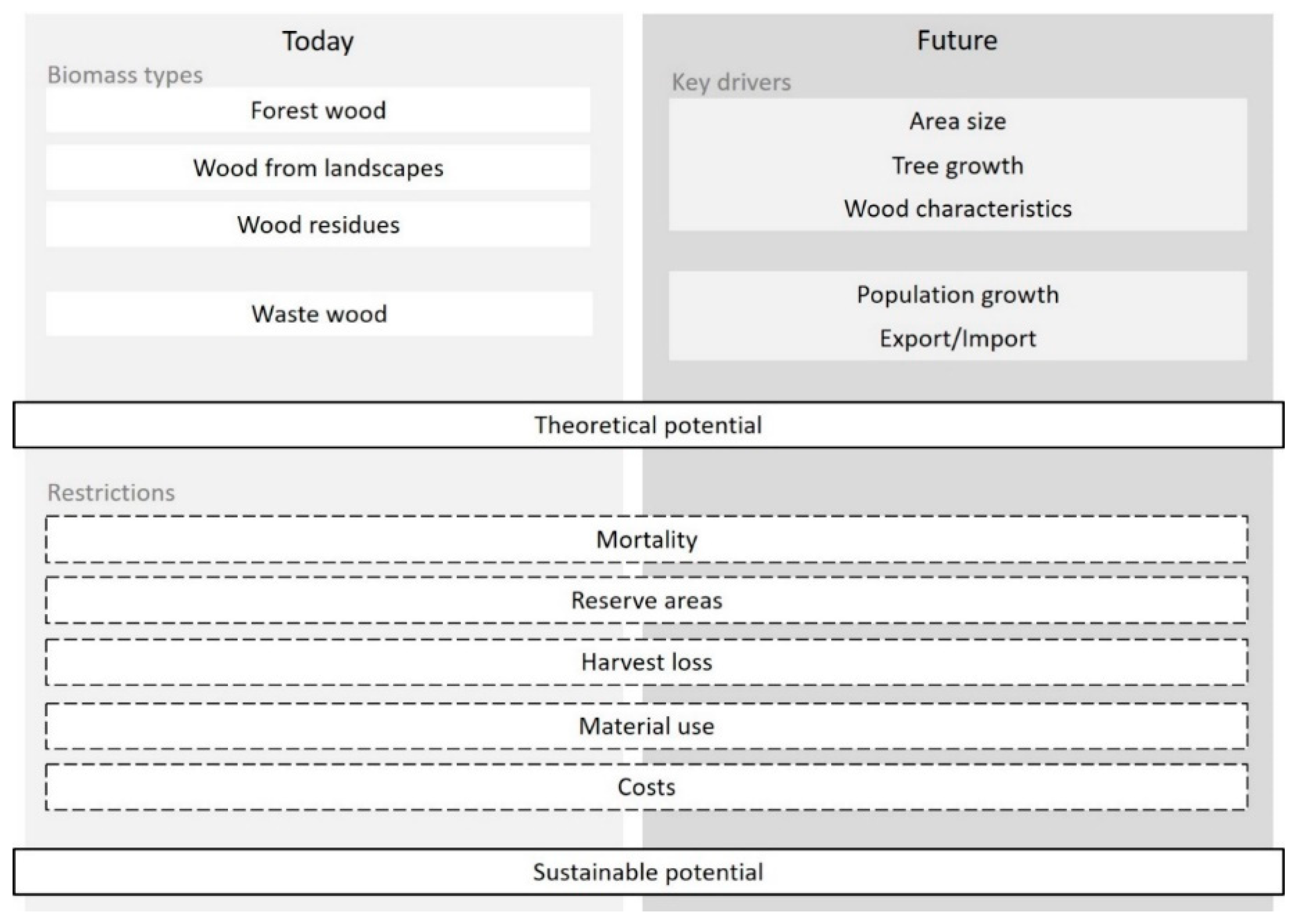


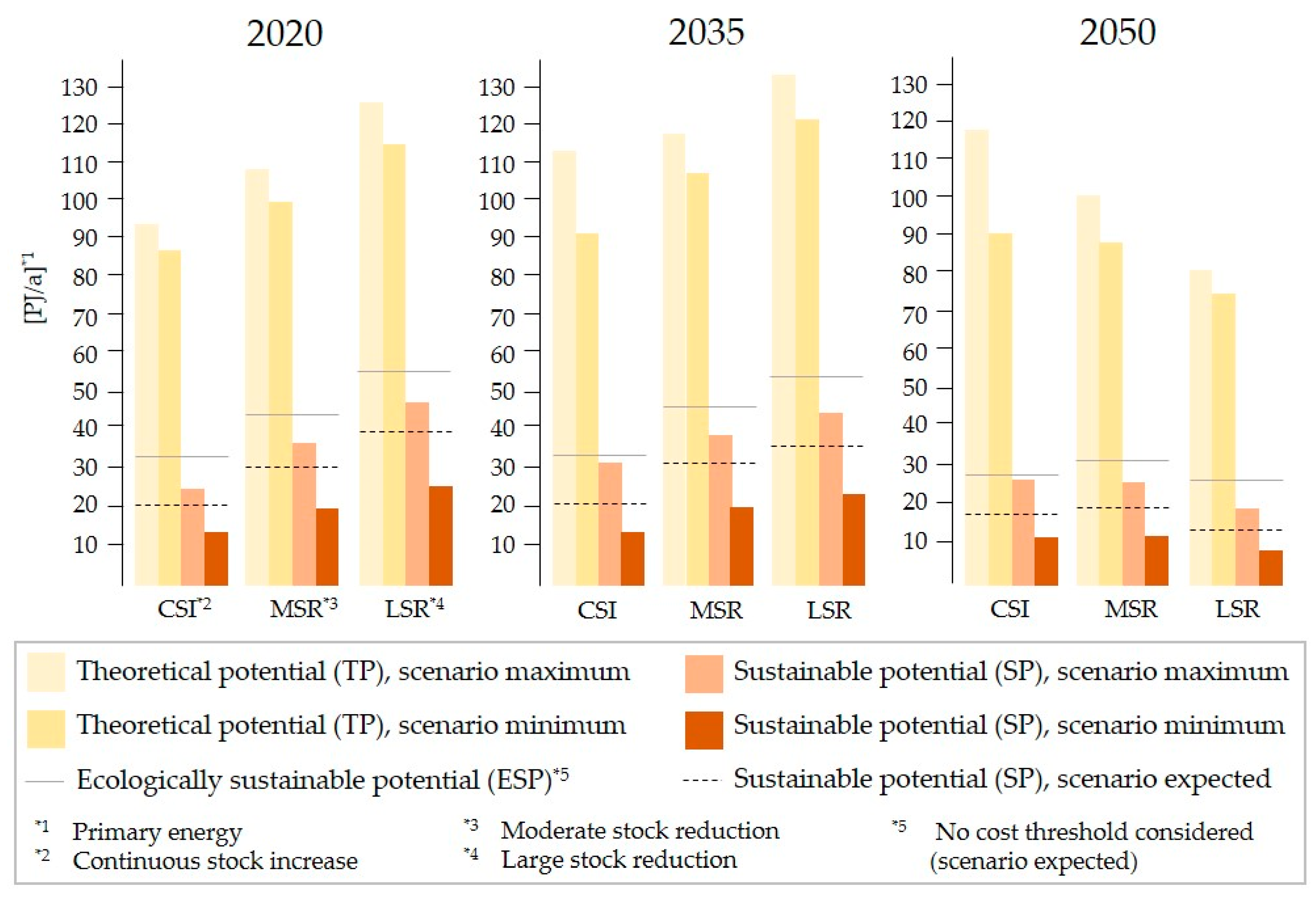
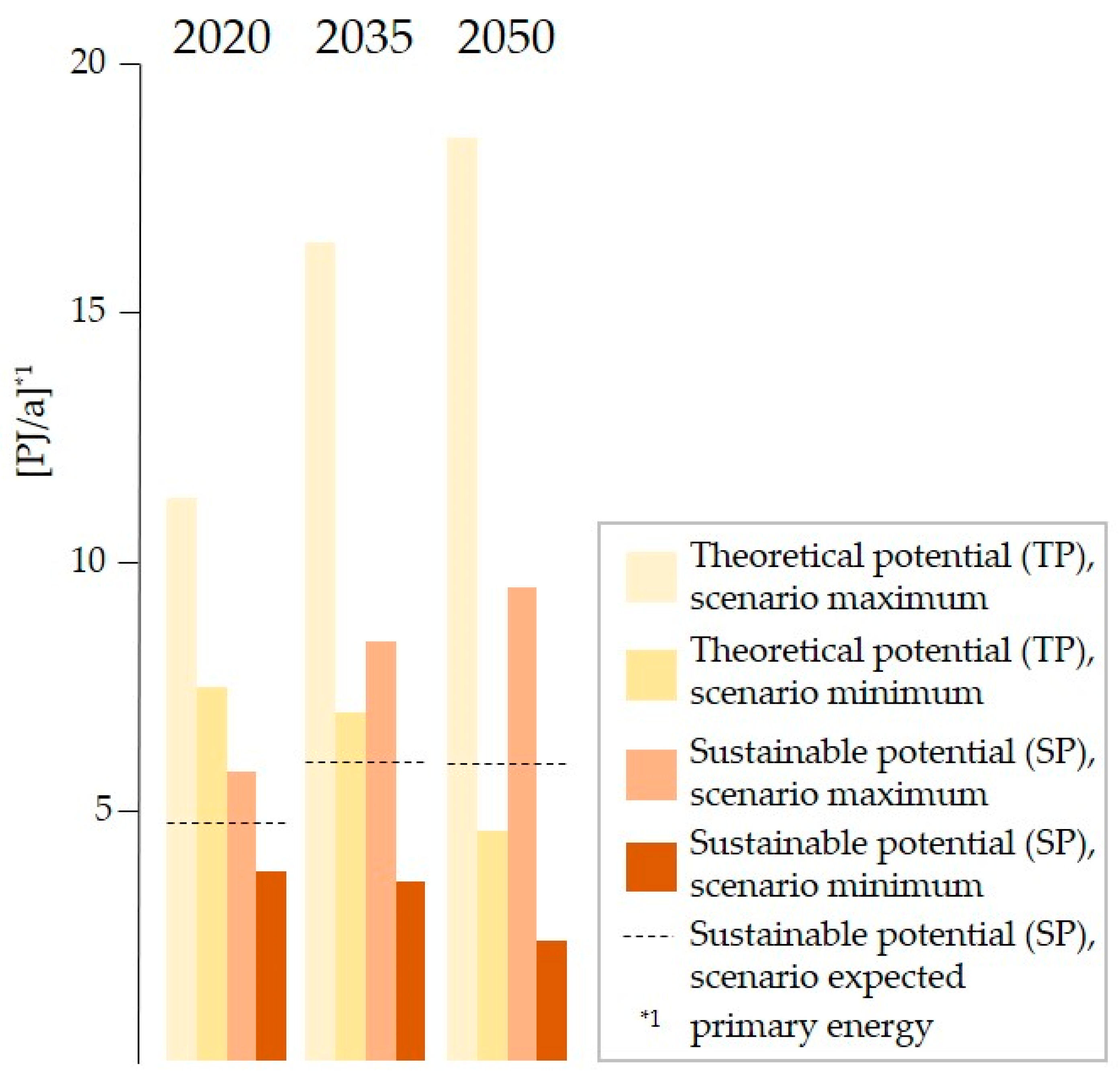
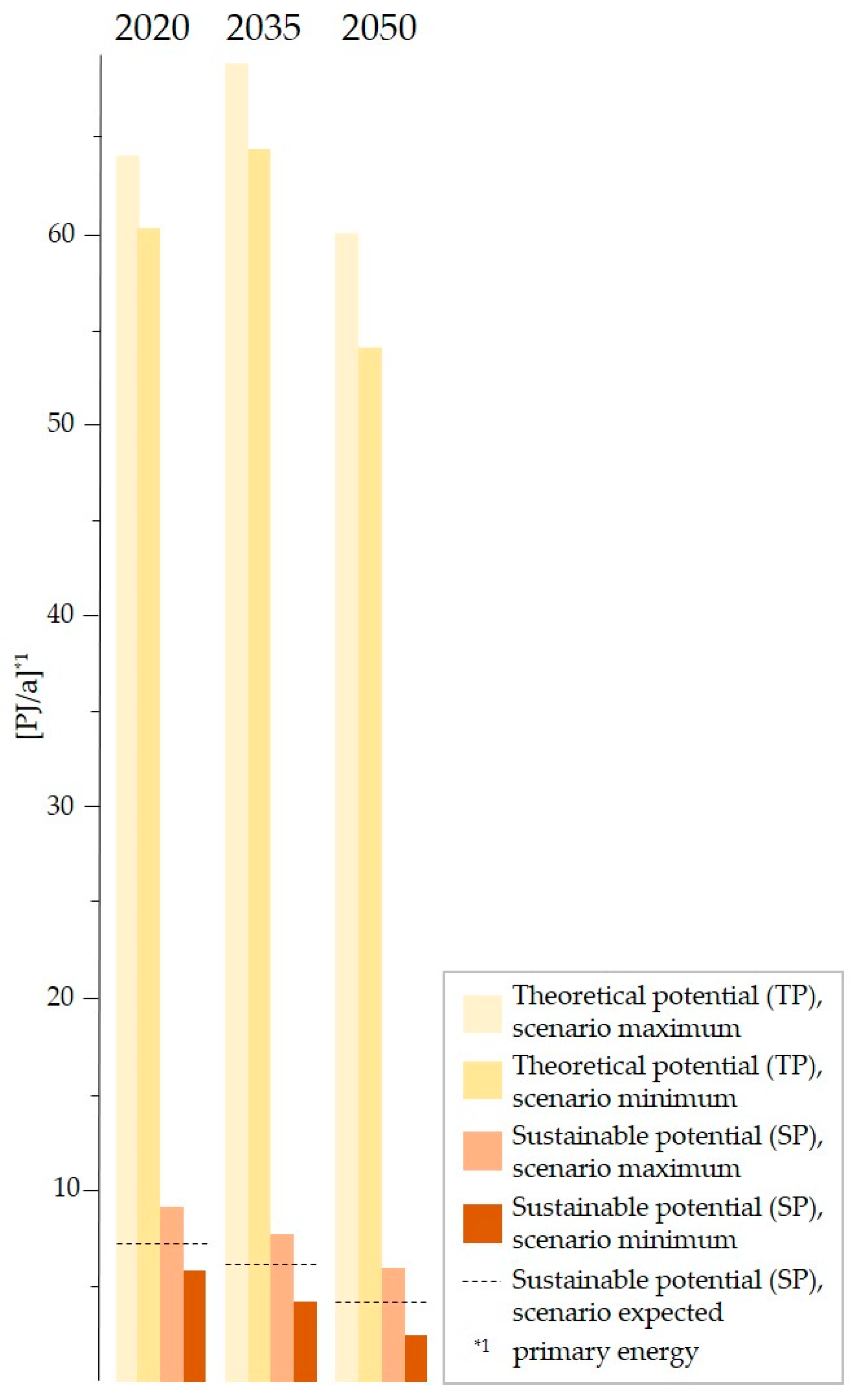
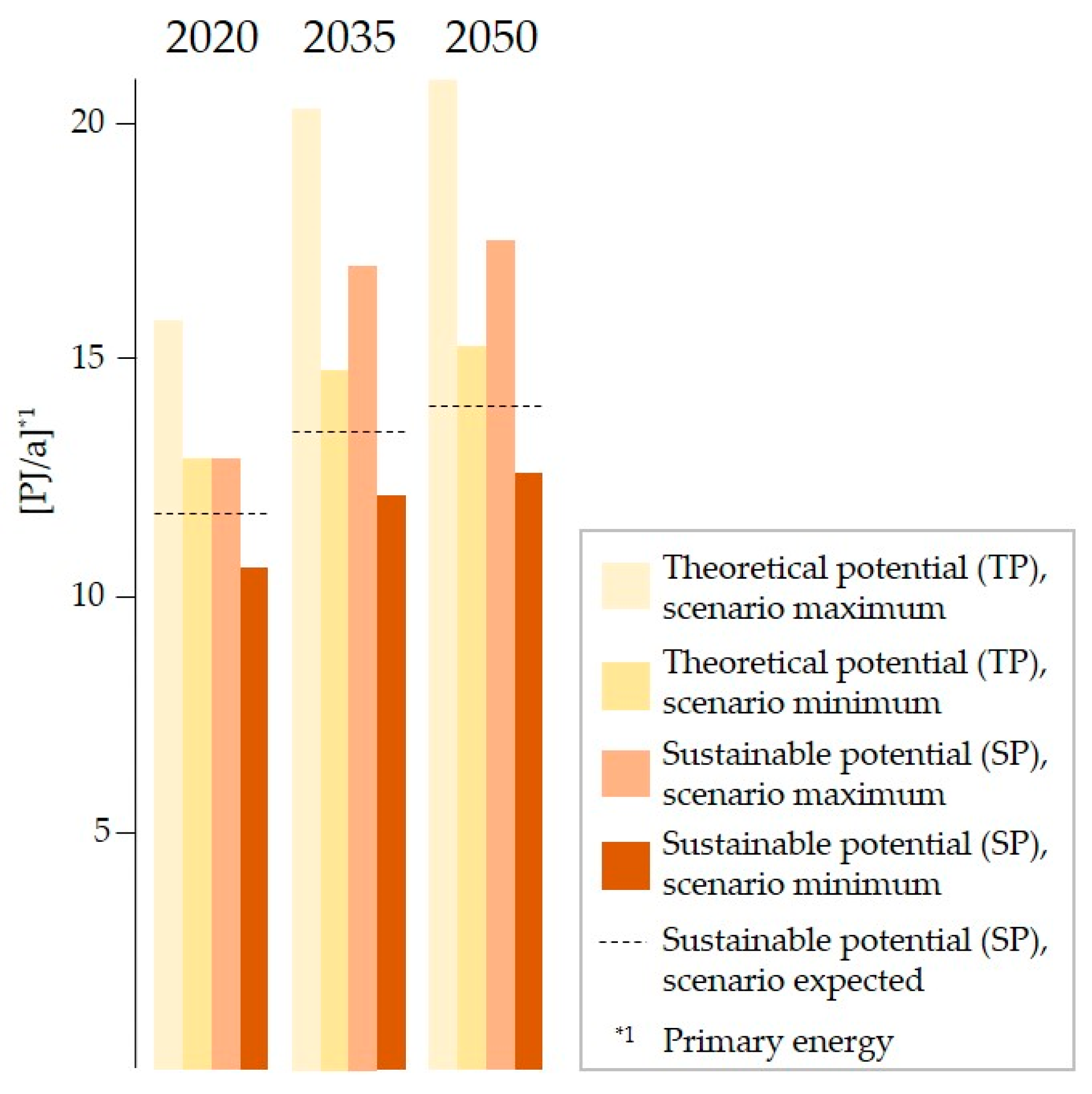
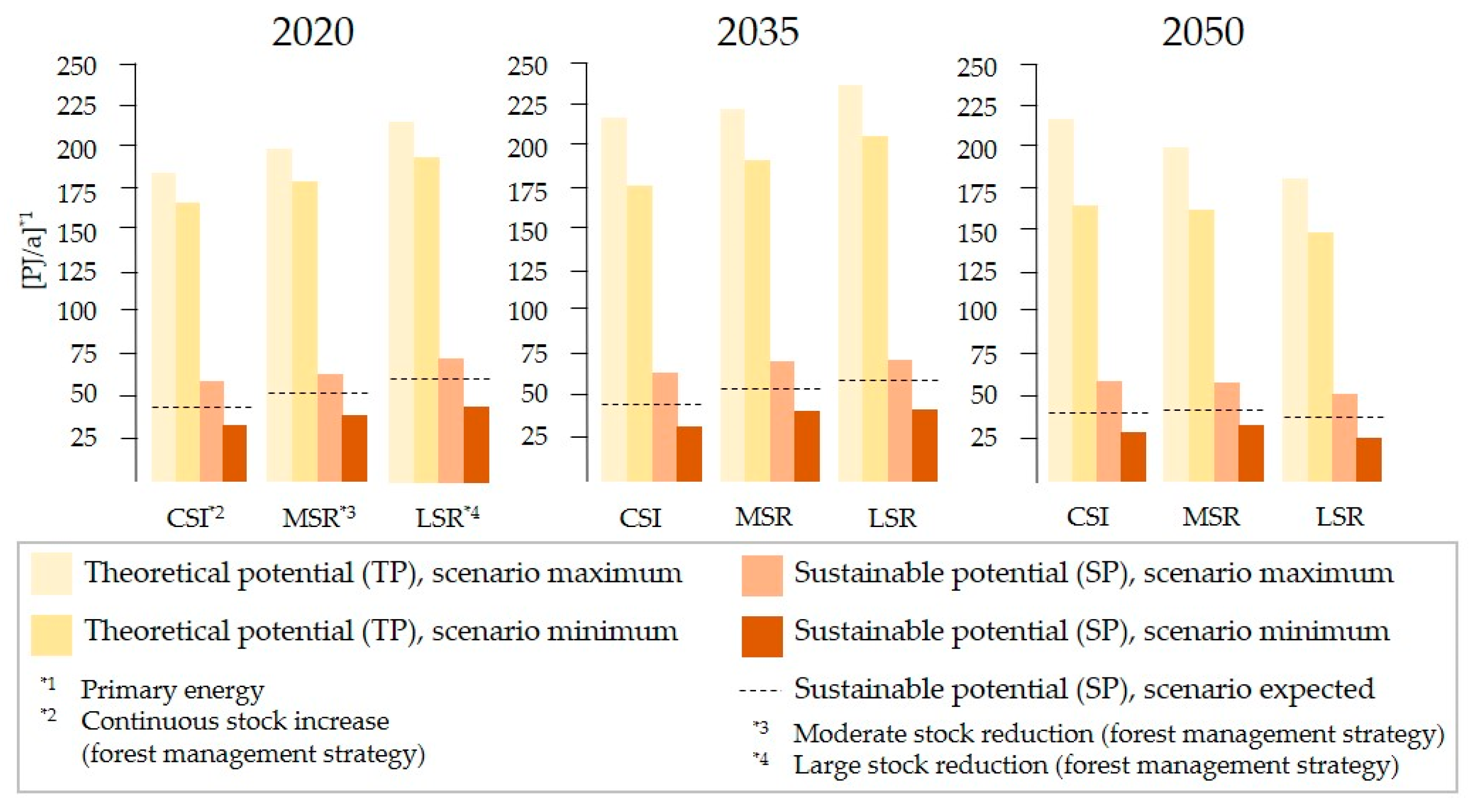
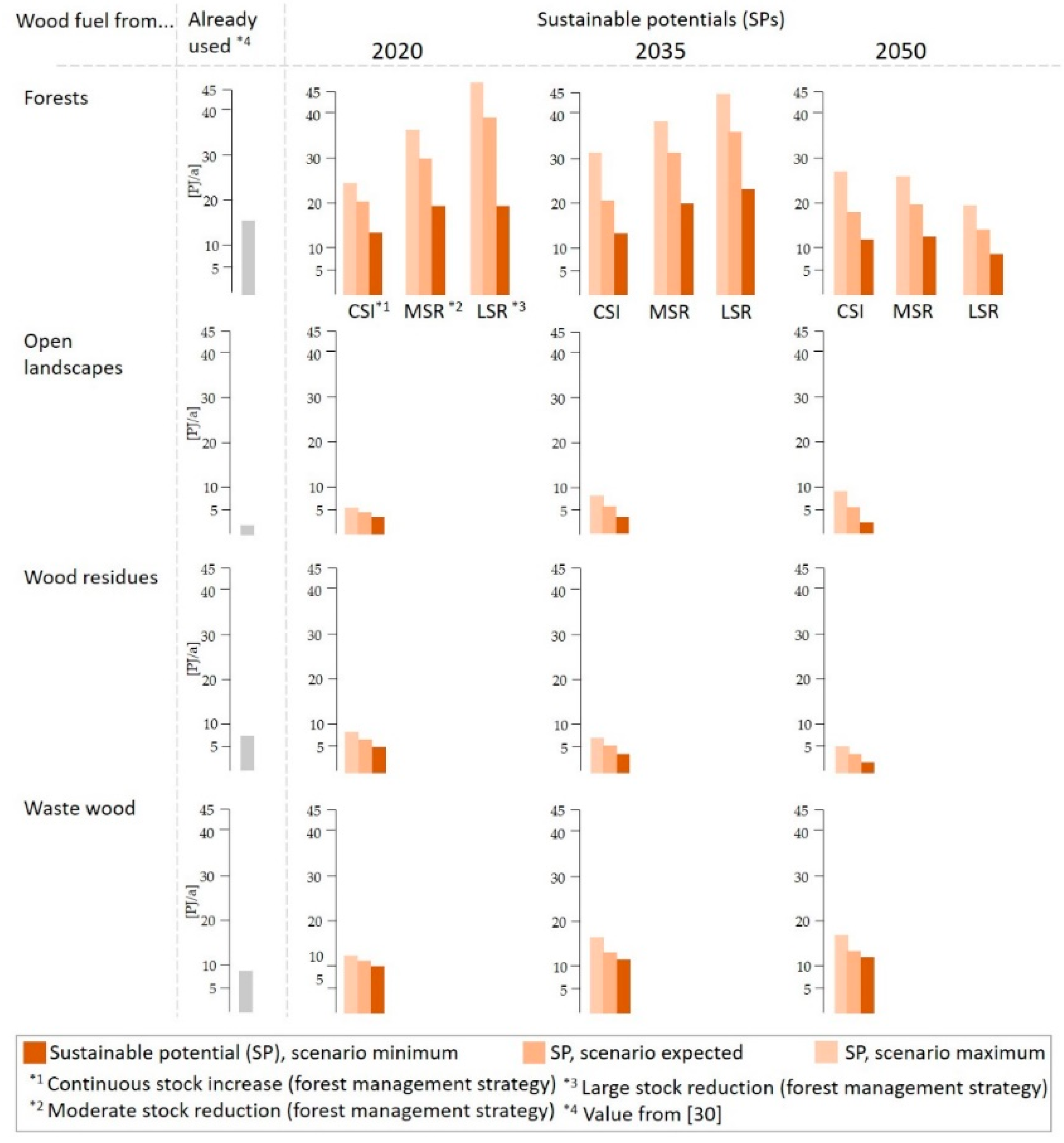
| Time/Management Strategy | CSI | MSR | LSR |
|---|---|---|---|
| 2020 | 2.6% | 3.0% | 3.4% |
| 2035 | 9.2% | 3.4% | 3.4% |
| 2050 | 11.7% | 5.3% | 2.9% |
| Harvest Losses | Conifers | Broadleaves | ||
|---|---|---|---|---|
| Merchantable | Brushwood | Merchantable | Brushwood | |
| Minimum wood fuel SPs | 9% | 61% | 16% | 55% |
| Maximum wood fuel SPs | 7% | 55% | 10% | 45% |
| Categories of Wood from Landscapes | Modelling | Notes |
|---|---|---|
| Built-up areas | All the areas are considered for the calculation of SPs | Maintenance and management due to safety aspects |
| Transportation areas | ||
| Agricultural areas, tree and brush vegetation | Only areas with a slope <70% were considered | Safety aspects not relevant |
| Groves, hedges | ||
| Embankments (of rivers and lakes) |
| Restriction | Specification | Minimum | Expected | Maximum |
|---|---|---|---|---|
| Mortality [%] | -/15/- | |||
| Reserve areas [%] | SP2020 | ~10.0 | 4.8 | 4.8 |
| 2035 and 2050 | ~10.0 | ~10.0 | ~10.0 | |
| SP2035/2050 | ~10.0 | ~10.0 | ~10.0 | |
| Harvest losses [%] | Conifers brushwood (incl. bark) | 61 | 58 | 55 |
| Conifers merchantable | 9 | 8 | 7 | |
| Broadleaves brushwood (incl. bark) | 55 | 50 | 45 | |
| Broadleaves merchantable | 16 | 13 | 10 | |
| Costs [CHF/m3] | Wood production forests | 110.0 | 120.0 | 130.0 |
| Protection forests | 180.0 | 190.0 | 200.0 | |
| Forest Management | 2020 [PJ] | 2035 [PJ] | 2050 [PJ] |
|---|---|---|---|
| CSI *1 | 34.1–59.5 | 33.6–64.8 | 29.8–60.3 |
| MSR *1 | 40.1–64.5 | 42.7–71.8 | 30.4–59.4 |
| LSR *1 | 45.9–75.1 | 43.5–77.8 | 26.5–52.9 |
Publisher’s Note: MDPI stays neutral with regard to jurisdictional claims in published maps and institutional affiliations. |
© 2020 by the authors. Licensee MDPI, Basel, Switzerland. This article is an open access article distributed under the terms and conditions of the Creative Commons Attribution (CC BY) license (http://creativecommons.org/licenses/by/4.0/).
Share and Cite
Erni, M.; Burg, V.; Bont, L.; Thees, O.; Ferretti, M.; Stadelmann, G.; Schweier, J. Current (2020) and Long-Term (2035 and 2050) Sustainable Potentials of Wood Fuel in Switzerland. Sustainability 2020, 12, 9749. https://doi.org/10.3390/su12229749
Erni M, Burg V, Bont L, Thees O, Ferretti M, Stadelmann G, Schweier J. Current (2020) and Long-Term (2035 and 2050) Sustainable Potentials of Wood Fuel in Switzerland. Sustainability. 2020; 12(22):9749. https://doi.org/10.3390/su12229749
Chicago/Turabian StyleErni, Matthias, Vanessa Burg, Leo Bont, Oliver Thees, Marco Ferretti, Golo Stadelmann, and Janine Schweier. 2020. "Current (2020) and Long-Term (2035 and 2050) Sustainable Potentials of Wood Fuel in Switzerland" Sustainability 12, no. 22: 9749. https://doi.org/10.3390/su12229749
APA StyleErni, M., Burg, V., Bont, L., Thees, O., Ferretti, M., Stadelmann, G., & Schweier, J. (2020). Current (2020) and Long-Term (2035 and 2050) Sustainable Potentials of Wood Fuel in Switzerland. Sustainability, 12(22), 9749. https://doi.org/10.3390/su12229749





